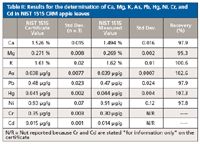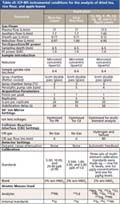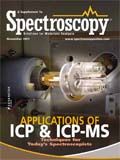Ensuring the Safety and Quality of Foodstuffs Produced in China: The Role of ICP-MS
This study focuses on the use of inductively coupled plasma–mass spectrometry (ICP-MS) in Chinese laboratories for measuring toxic, essential, and nutritional elements in foods. In particular, we describe recent advances in detection systems and interference removal capabilities to provide fast and simple multielement analysis over a wide concentration range for many different types of food samples.
This study focuses on the use of inductively coupled plasma–mass spectrometry (ICP-MS) in Chinese laboratories for measuring toxic, essential, and nutritional elements in foods. In particular, we describe recent advances in detection systems and interference removal capabilities to provide fast and simple multielement analysis over a wide concentration range for many different types of food samples.
Globalization of the food industry has opened up new markets to many countries, resulting in greater scrutiny by regulatory agencies and driving the need for increased food testing and safety. China, in particular, is a major provider of food products on a global scale, ranking in the top five nations for food-related exports. Unfortunately, a number of food scares, including melamine contamination in pet foods and infant formula, has placed China in the headlines for all of the wrong reasons. China is a key supplier of fruits, vegetables, rice, nuts, beans, and products derived from them, including juices, preserves, pastes, and purees. For example, according to Food and Agriculture Organization of the United Nations (FAOSTAT), China was by far the biggest exporter of nonconcentrated apple juice and the third largest exporter of tea in 2008, exporting more than $1.1 billion and $0.7 billion, respectively (1).
The Chinese government is committed to protecting consumers and customers. This is illustrated by the annual China International Food Safety & Quality (CIFSQ) conference and exposition, which will be held in Beijing this November (2). Now in its fifth year, this conference brings together regulators and industry stakeholders from around the world, giving them the opportunity to meet, collaborate, and provide solutions to strengthen global food safety. The demand for improvements in food quality also has seen a rise in the demand for analytical instrumentation over the past decade as laboratories strive to meet ever-more stringent food quality regulations. Techniques such as gas chromatography–mass spectrometry (GC–MS) and liquid chromatography–mass spectrometry (LC–MS) for detecting and quantifying pesticide levels; nuclear magnetic resonance (NMR) for product classification and ingredient identification of juices; and inductively coupled plasma–mass spectrometry (ICP-MS) for carrying out the multielement determinations of macro and trace minerals in foodstuffs, are all powerful analytical tools commonly used in Chinese food testing laboratories.
Elemental Nutrients in Food
Foods and agricultural crops contain various concentrations of nutrients, which can range from trace amounts to percentage levels. However, while most of their nutritional content is intended for maintaining good health, the benefits of the desired mineral content can be compromised by concentrations of elements considered to be toxic to humans or animals. The health effects of dietary exposure to different levels of minerals and metals have been widely investigated, and based on the concentrations at which deficiencies and toxicities are observed, inorganic elements may be divided into four main groups:
- Macrominerals: A regular intake of large quantities of elements such as Ca, Mg, Na, K, P, S, Fe, Cu, and Zn is needed to sustain life.
- Essential minerals: A smaller quantity of each of these elements ensures good health. Examples include Mn, Cr, Se, B, Br, Si, I, V, Li, Mo, Co, Ge, and others.
- Trace elements: Some studies propose the human body's requirement for other elements like F, As, Rb, Sn, Nb, Sr, Au, Ag, Cr, and Ni.
- Toxic metals: Dietary intake of deleterious elements such as Be, Hg, Pb, Cd, Al, Sb, Bi, Ba, and U should be minimized.
Greater exposure to toxic metals in the modern diet has been suggested as a contributing factor to the increase in diseases such as diabetes, hypothyroidism, and cancer. Similarly, looking upstream in our food supply chains and in particular to the agricultural industry, it is becoming increasingly clear that providing the correct balance of macrominerals and trace metals in the feed of livestock helps them thrive and remain disease-free. For example, magnesium intake is critical to prevent grass tetany, a fatal metabolic disorder in cattle. Selenium is known to be a major factor in the fertility of cows, and cobalt supplements are often necessary for the well-being of sheep. Accurate measurement of elemental composition in food and agricultural products is therefore essential to ensure product safety and maintain adequate levels of nutritional content.
The Role of ICP-MS
ICP-MS is particularly ideal for characterizing the elemental composition of food materials because it provides a fast and relatively simple multielement characterization over a wide concentration range for many different sample types. With recent advances in technology, including detection systems and interference removal techniques, the toxic elements that are often present at ultratrace levels can now be measured accurately at the same time as essential and nutritional minerals, which are often present at high parts-per-million levels or low percentage levels. As a result, ICP-MS is now routinely used in Chinese laboratories for measuring the full suite of elements in foods. Before we take a look at what is driving these applications, let's remind ourselves why ICP-MS is ideally suited for the analysis of foodstuffs, compared to other trace element techniques, such as inductively coupled plasma–optical emission spectrometry (ICP-OES), flame atomic absorption (FAA), and electrothermal atomization (ETA).
- ICP-MS typically offers very high sensitivity and extremely low detection limits, especially for heavy metals. For example, the detection limit for Pb is approximately 2–3 orders of magnitude lower than ETA, 4 orders of magnitude lower than ICP-OES, and more than 5 orders of magnitude lower than FAA (3).
- The technique is a rapid multielement technique covering 8–9 orders of linear dynamic range, meaning parts-per-trillion (ppt) levels can be determined in the same sample as high parts-per-million concentrations. By comparison, ICP-OES offers 5–6 orders, FAA offers 3–4 orders, and ETA offers only 2–3 orders of linearity.
- High and low analyte concentrations can be determined in the same sample run using a pulse-only detection system. This capability eliminates the need for analog measurements, which allows the dynamic range to be extended without having to carry out regular and time consuming cross-calibration of the detector in a multielement analysis (4).
- Isotopic measurements are unique to ICP-MS compared to the other atomic spectroscopic techniques. This means that analyses such as nutritional isotope ratio tracer studies can be carried out to study the adsorption of certain minerals into the bloodstream. Traditionally, this has been the domain of multicollector magnetic sector instruments, but with the recent development of all-digital (pulse-only) detectors, excellent precision can be obtained for isotope ratios covering concentrations over the full dynamic range (5).
- Spectral interferences created by the sample matrix and plasma gas have traditionally been a problem in ICP-MS. However, with the development of collision and reaction cells and interfaces about 10 years ago, the technique is now capable of determining elements such as As, Se, Cr, V, and Fe at the parts-per-trillion level in the presence of problematic sample matrices that generate polyatomic species derived from Ar, O, H, Cl, and C ions (6).
National Food Safety Standard (NFSS) Maximum Levels of Contaminants in Food
On August 12, 2010, China's Ministry of Health, under the guidance of the Chinese Center for Disease Control Nutrition and Food Safety (CCDCNFS), notified the World Trade Organization (WTO) that it was replacing GB 2762-2005, the National Standard for the Maximum Levels of Contaminants in Foods, with a new standard to address the maximum levels of lead, cadmium, mercury, arsenic, tin, nickel, chromium, nitrate, nitrite, benzo[a]pyrene, N-nitrosamines, polychlorinated biphenyls, and 3-chloro-1,2-propanediol in foodstuffs (7). This standard, which is yet to be given a numerical identification, will replace the previous standard, GB 2762-2005 (8). The major modifications being proposed in the new standard are as follows:
- Maximum contaminant levels for some of the of existing foods have been adjusted, together with the inclusion of a number of additional foodstuffs to reflect Codex Alimentarious Commission (CAC) standards, a joint publication of the Food and Agricultural Organization (FAO) of the United Nations and the World Health Organization (WHO) (9).
- The new standard includes a definition for "edible parts" of the food and prescribe that the maximum levels only apply to the edible or drinkable parts of the food raw materials after the nonedible parts are removed by mechanical means.
- Elimination of selenium, aluminum, fluorine, and the rare earth elements from the standard.
- Addition of tin, 3-chloro-1,2-propanediol, and nitrate to the standard.
- The N-nitrosamine standard will be defined as N-nitrosodimethylamine and not a combination of N-nitrosodimethylamine and N-dimethylnitrosamine.
This new standard is clearly China's attempt to improve its image with the international community. For example, the number of food products listed for lead (Pb) has increased from 17 in 2005 to 58 in the new standard. Some of the food products that have been added include bottled water, carbonated beverages, chocolate products, jams and preserves, and bakery items, which is a reflection of China's status as a leading exporter in today's global economy. Many of the other analytes specified in the standard also have additional food materials listed.
Analysis of Foodstuffs by ICP-MS
Now let's take a brief look at some typical applications researchers are carrying out with ICP-MS to support this new Chinese standard. The study is not meant to be comprehensive, but rather an overview of what is being done by Chinese laboratories and the capability of cutting-edge technology like ICP-MS to address their analytical needs. The three applications highlighted will be
- Determination of Pb, which in tea demonstrates the ability of the technique to measure single-digit milligram-per-kilogram (parts-per-million) levels of lead in dried tea leaves. This work was carried out by researchers at the Ministry of Agriculture's Food Quality Supervision and Testing Center in Shanghai. The sample data are the researchers' own quality control (QC) standards and samples and are not yet published.
- Determination of Cd in rice, which demonstrates the ability of ICP-MS to measure even lower microgram-per-gram (parts-per-billion) levels of cadmium in rice flour. This work was also carried out by researchers at the Ministry of Agriculture's Food Quality Supervision and Testing Center in Shanghai. The sample data are the researchers' own QC standards and samples and are not yet in the public domain.
- Determination of Ca, Mg, K, Pb, Cd, Hg, As, Sn, Ni, and Cr in apple leaves. This work highlights the capability of ICP-MS to determine elements at high (%) levels together with elements at trace (microgram-per-gram) levels in the same multielement analysis of a NIST certified reference material. This work was carried out at our own application laboratory and is currently unpublished.
Even though the work was done in two laboratories, all samples were brought into solution with a MARS 5 (CEM Corporation, Matthews, North Carolina) microwave digestion system using a similar sample preparation methodology, described below.
Microwave Digestion Protocol
A 0.2–0.5 g sample was weighed into a digestion vessel. Then, 7 mL of 70% nitric acid was added, the pressure cap was tightened, and the vessel was inserted into the microwave oven, which used the temperature-control mode shown in Table sI (available online). After digestion, the solutions were made up with 18-MΩ ultrapure water to a volume of 50 mL or 100 mL, depending on the sample type.

Table sI: Microwave digestion protocol for the analysis of foodstuffs by ICP-MS
After they were in solution, the analytes were determined by ICP-MS with a Bruker (Fremont, California) Aurora M90 system using the instrument conditions and calibration standards shown in Table sII (available online). This system has been described in the open literature, but it is basically a high sensitivity instrument that uses a 90° ion mirror and off-axis quadrupole. Additionally, it uses a collision reaction interface (CRI) where collisional and reactive gases are bled into the skimmer cone to minimize the formation of problematic polyatomic ions. The instrument also offers the capability to extend the linear dynamic range using a pulse-only detection system to determine percentage levels at the same time as measuring trace and ultratrace analyte concentrations (10).

Table sII: ICP-MS instrumental conditions for the analysis of dried tea, rice flour, and apple leaves
There are a number of points that should be emphasized:
- Even though this study only reported nine elements specified in the new National Food Safety Standard, 18 elements were determined in the NIST 1515 CRM apple leaves.
- For the analysis of apple leaves, the lens voltages were automatically adjusted to maximize the ion signal for the nine elements being determined. For the analysis of the tea leaves and rice flour, the ion lens voltage optimization was weighted toward Pb and Cd.
- No CRI gas was used for the determination of Pb or Cd, because these analytes are basically free of spectral interferences in these matrices. For the multielement analysis of apple leaves, a mixture of hydrogen and helium gas was bled into the skimmer cone interface to minimize the impact of polyatomic interferences such as Ar+ , ArH+ , ArO+ , ArC+ , and CC+ .
- No signal attenuation was required for the determination of Pb or Cd because the analyte concentrations were extremely low. However, for the analysis of the apple leaves, Ca, Mg, and K were present at low percentage levels, which made it necessary to extend the dynamic range with the automated pulse-only, digital detector to allow the determination of the other low parts-per-million analytes at the same time.
Results
The results for the analysis of a quality control standard plus an actual unknown tea leaf and rice flour sample are shown in Table I, and the multielement analysis of NIST 1515 CRM apples leaves, including statistical data, is shown in Table II.

Table I: Results for the determination of Pb in tea leaves and Cd in powdered rice
Conclusion
China's image as a global supplier and exporter of foodstuffs has been severely tarnished over the past few years by various food safety and contamination scares. The new National Food Safety Standard is clearly China's attempt to improve its standing with the international community. Only time will tell whether this regulatory mandate by the Chinese Ministry of Health will bring Chinese food producers into line with the stricter quality protocols of manufacturers in the United States and Europe.

Table II: Results for the determination of Ca, Mg, K, As, Pb, Hg, Ni, Cr, and Cd in NIST 1515 CRM apple leaves
This study also has shown that ICP-MS will play a very important role in this effort. There is no question that to meet many of the new levels and additional foodstuffs prescribed in the standard, existing elemental techniques like AA and ICP-OES are just not going to be able to meet the detection limits, multielement capability, and sample throughput demands of modern food laboratories. There is no question that by investing in other cutting-edge analytical tools like LC–MS, GC–MS, and NMR, in addition to ICP-MS, Chinese researchers are showing the world that they are capable of meeting this demand.
This brief study shows that recent innovations in ICP-MS have enabled researchers to determine extremely low concentrations of elements like Pb and Cd at microgram-per-kilogram (parts-per-billion) levels in the solid material. In addition, when required, the technique has the ability to accurately measure macrominerals such as Ca, Mg, and K that are present at low percentage levels, together with essential trace metals like Cr and Ni, and ultratrace levels of toxic metals like Cd and Hg in the same multielement method.
Andrew Ryan is an ICP-MS product manager with Bruker in Preston, Australia. Robert Thomas is a principal consultant with Scientific Writing Solutions in Laytonsville, Maryland. Direct correspondence to: robert.james.thomas@verizon.net.
Supplementary Information

Table sI: Microwave digestion protocol for the analysis of foodstuffs by ICP-MS

Table sII: ICP-MS instrumental conditions for the analysis of dried tea, rice flour, and apple leaves
References
(1) Food and Agriculture Organization of the United Nations (FAOSTAT) website: http://faostat.fao.org/site/342/default.aspx.
(2) China International Food Safety & Quality (CIFSQ) Conference and Expo: http://www.chinafoodsafety.com.
(3) Bruker Daltonics Application Note CA-270112:
www.bdal.com/uploads/media/CA-270112_Innovative_High_Sensitivity_90-degree_Reflecting_ICP-MS.pdf.
(4) Bruker Daltonics Application Note CA-270104:
(5) B. Shaulis, T.J. Lapen, and A. Toms, Geochemistry, Geophyics, Geosystems (G3)11, November (2010).
(6) Bruker Daltonics Application Note CA-270111:
(7) National Standard for the Maximum Levels of Contaminants in Foods, Chinese Ministry of Health (G/SPS/N/CHN/312, August, 2010 (USDA Report):
(8) National Standard for the Maximum Levels of Contaminants in Foods, Chinese Ministry of Health, GB 2762-2005, October 1, 2005 (USDA Report):
http://www.fas.usda.gov/gainfiles/200608/146208660.pdf.
(9) Codex Alimentarious Commission (CAC):
http://www.codexalimentarius.net/web/index_en.jsp.
(10) Bruker Daltonics CA-270102:

High-Speed Laser MS for Precise, Prep-Free Environmental Particle Tracking
April 21st 2025Scientists at Oak Ridge National Laboratory have demonstrated that a fast, laser-based mass spectrometry method—LA-ICP-TOF-MS—can accurately detect and identify airborne environmental particles, including toxic metal particles like ruthenium, without the need for complex sample preparation. The work offers a breakthrough in rapid, high-resolution analysis of environmental pollutants.
Trending on Spectroscopy: The Top Content of 2024
December 30th 2024In 2024, we launched multiple content series, covered major conferences, presented two awards, and continued our monthly Analytically Speaking episodes. Below, you'll find a selection of the most popular content from Spectroscopy over the past year.